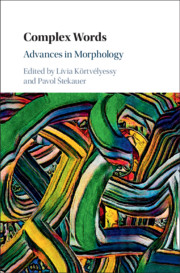Book contents
- Complex Words
- Complex Words
- Copyright page
- Dedication
- Contents
- Contributors
- Introduction: Advances in Morphology
- Part I Lexico-Semantic Aspects of Complex Words
- Part II Structure of Complex Words
- Part III Corpus-Based Case Studies
- 13 Competition between Synthetic NN Compounds and NN.gen Phrasal Nouns in Polish
- 14 An S Is an ’S, or Is It? Plural and Genitive Plural Are Not Homophonous
- 15 The Role of Word-Formation Families and Subfamilies in the Organization of German Diminutive Compounds
- 16 Semantic Patterns in Noun-to-Verb Conversion in English
- 17 Onomatopoeia
- 18 Dingsbums and Thingy
- Index
- References
17 - Onomatopoeia
On the Crossroads of Sound Symbolism and Word Formation
from Part III - Corpus-Based Case Studies
Published online by Cambridge University Press: 18 September 2020
- Complex Words
- Complex Words
- Copyright page
- Dedication
- Contents
- Contributors
- Introduction: Advances in Morphology
- Part I Lexico-Semantic Aspects of Complex Words
- Part II Structure of Complex Words
- Part III Corpus-Based Case Studies
- 13 Competition between Synthetic NN Compounds and NN.gen Phrasal Nouns in Polish
- 14 An S Is an ’S, or Is It? Plural and Genitive Plural Are Not Homophonous
- 15 The Role of Word-Formation Families and Subfamilies in the Organization of German Diminutive Compounds
- 16 Semantic Patterns in Noun-to-Verb Conversion in English
- 17 Onomatopoeia
- 18 Dingsbums and Thingy
- Index
- References
Summary
This paper provides a contrastive analysis of English and Slovak onomatopoeia with regard to both its theoretical comprehension in two different linguistic traditions and its characteristics in two typologically different languages. The emphasis is on (i) the onomatopoeia-founded word-formation processes and (ii) the semantic characteristics of complex words derived from onomatopoeia. The latter will focus on the identification of metaphorical and metonymical shifts from the cognitive-semantic point of view. Our sample includes 120 Slovak and 115 English onomatopoetic words. In addition, we argue that (i) onomatopoeia differs from interjections and therefore should not be classified within this class of words, and (ii) the scope of onomatopoeia should not be extended beyond its inherent feature of being imitations of sounds by means of a language-specific system of phonemes. By implication, no complex word derived from onomatopoeia should be treated as genuine onomatopoeia.
Keywords
- Type
- Chapter
- Information
- Complex WordsAdvances in Morphology, pp. 335 - 361Publisher: Cambridge University PressPrint publication year: 2020

